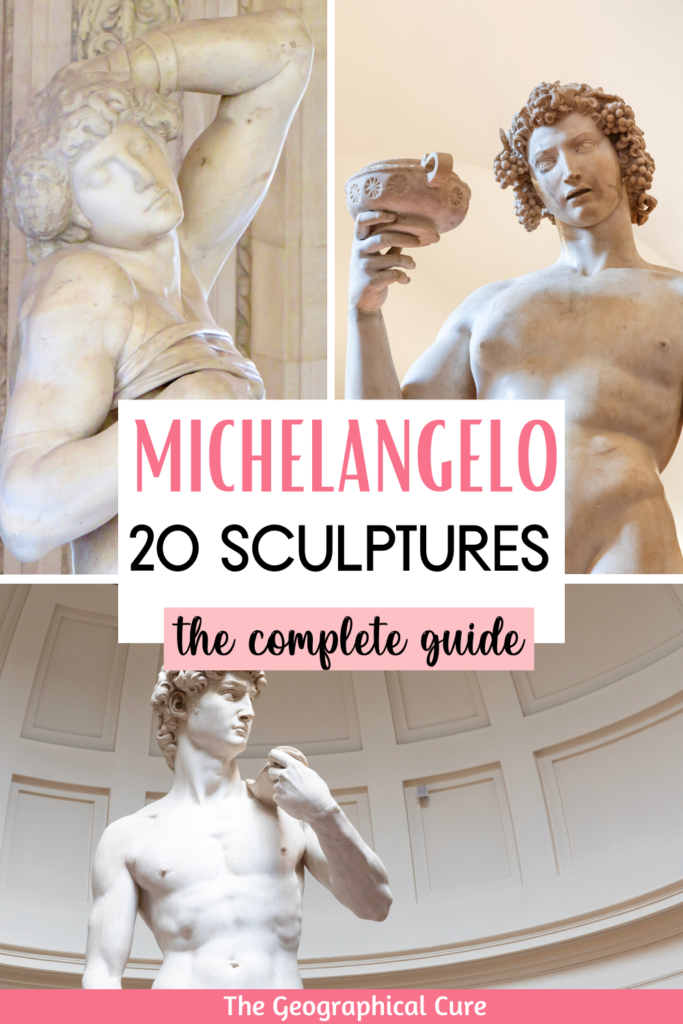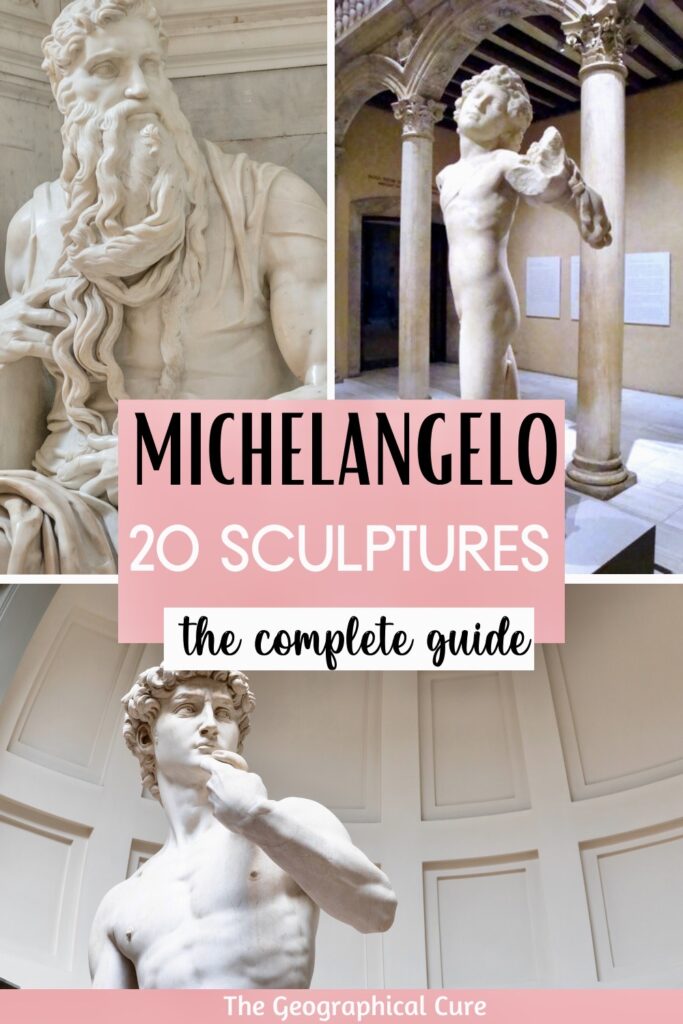Michelangelo is a renowned sculptor who’s undoubtedly one of the greatest artists in history. He’s famous for his ability to create lifelike and dynamic sculptures that take your breath away. In this guide, I’ll take you on a tour of Michelangelo’s most famous sculptures and explore the stories and techniques behind them.
For more than five centuries, Michelangelo has been celebrated as a Renaissance genius with exceptional skills in a range of mediums. During his lifetime, he was known as the “divine artist” and was recognized as a prodigy from a young age.
Michelangelo’s art is not only aesthetically pleasing but also groundbreaking in its innovation. He mastered the ability to create flawlessly rendered and idealized interpretations of the human form, capturing both psychological and physical realism with unmatched skill.
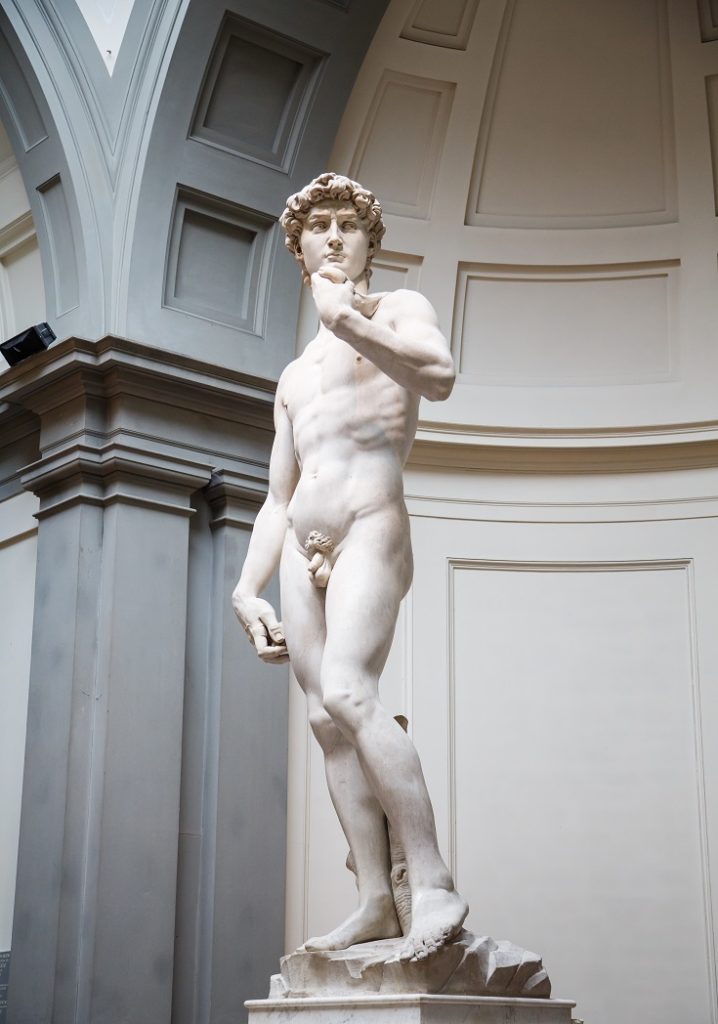
Most Famous Michelangelo Sculptures
Here’s a look at 20+ of Michelangelo’s best and most famous sculptures.
1. David, Galleria Accademia, Florence
David is widely considered the most famous sculpture in the world. With David, Michelangelo became a star, a Medici darling, and a new kind of public celebrity. At just age 23!
This Renaissance masterpiece stands at 17 feet tall and is often hailed as the epitome of male beauty – a model of physical perfection akin to a Calvin Klein ad.
The statue is based on an Old Testament story about David, an underdog who faces off against the giant Goliath. David, a brave young man, fights Goliath on behalf of the Israelites and defeats him using an unorthodox weapon — a slingshot and a stone — guided in part by the hand of God.
Michelangelo’s sculpture depicts David in the moment just before the battle. The figure exudes intense concentration as he scans for his opponent.
He is shown in a classical contrapposto stance, with a twist in his body that shifts most of his weight to one leg.
The statue shows Michelangelo’s remarkable knowledge of the human body. His experiments in dissecting cadavers helped him sculpt realistically. You can see David’s bulging veins, taut muscles, and rib cage.
David was commissioned by the Signoria, or City Council, for Florence Cathedral. Originally intended to be placed high up in a niche, the statue was ultimately deemed too beautiful for that location.
Instead, it was situated in the city’s main square, the Piazza della Signoria. It remained there until 1873, when it was finally moved inside the Accademia.
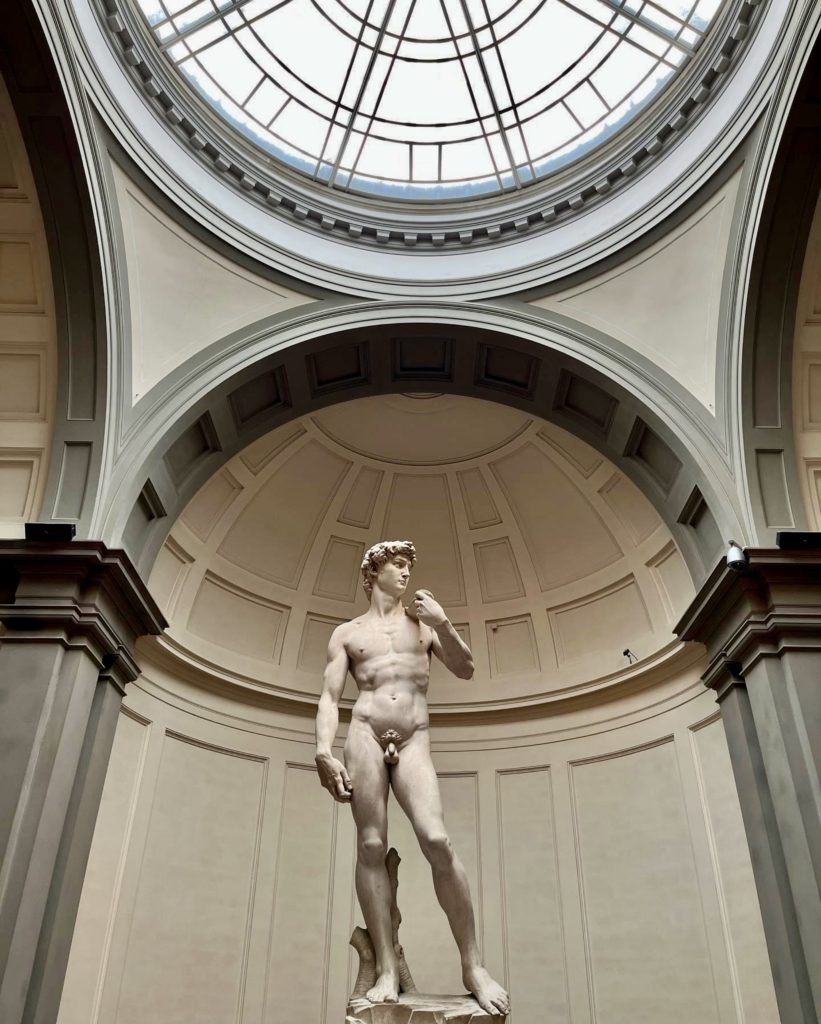
Originally, parts of David were gilded and polished. But that was lost during the statue’s exposure to the elements.
David also has a case of weak ankles. In 2014, diagnostics revealed tiny stress fractures in David’s ankles moving up the legs. This problem was caused by the ground shifting over time.
Unfortunately, the fissures can’t be fixed. But the gallery intends, at some point, to lift the statue and reinstall it on an anti-seismic base.
Here’s my guide to the Galleria Accadmia. This is one of the top attractions in Florence. To visit, you’ll need to pre-book a timed entry ticket.
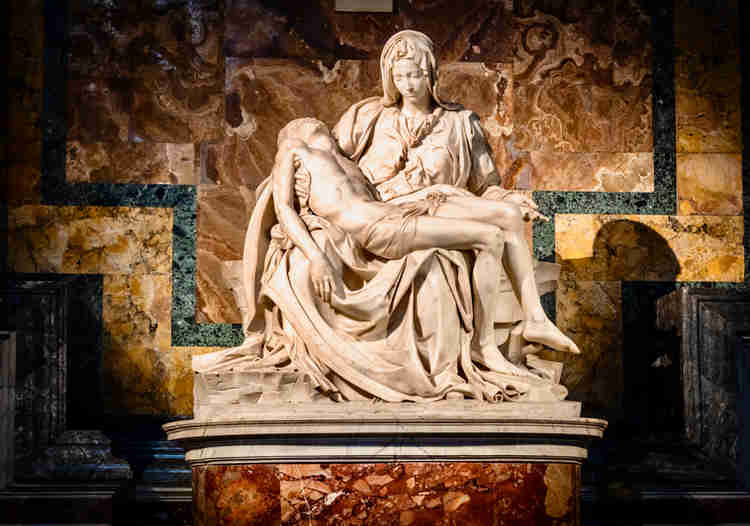
2. Pieta, St. Peter’s Basilica, Vatican City
After David, the Pieta is Michelangelo’s next most famous sculpture. It was his first number one hit at the ripe old age of 23.
You’ll find the Pieta behind bullet proof glass in St. Peter’s Basilica. The sculpture is situated in front of a large cross, almost like an installation piece.
The Pieta is a tragic and beautiful work of art, in which the stone appears almost soft. It depicts the Virgin Mary holding the body of Jesus after his crucifixion. Mary’s grieving and exquisite face is particularly striking.
It’s a powerful image of innocence, love, and compassion. The highly detailed and realistic carving of the figures and drapery make it a supreme masterpiece of Renaissance sculpture.
Interestingly, this is the only work that Michelangelo ever signed — his signature can be found across Mary’s sash. He later regretted this act of vanity and never signed another work.
In 1972, a mentally deranged geologist attacked the Pieta, resulting in its placement behind bulletproof glass. A 10 month restoration ensued, returning the sculpture to its former beauty.
3. Moses, St. Peter in Chains, Rome
Originally commissioned in 1505 for the tomb of Pope Julius II, Moses is one of Michelangelo’s most famous sculptures. It’s located in the Church of San Pietro in Vincoli in the Monti neighborhood of Rome.
Michelangelo referred to this commission as the “tomb tragedy.” Despite being his top priority, the artist was hijacked to work on the Sistine Chapel and other projects. When Julius died, funding ran out and Michelangelo wept over his unfinished masterpiece.
Moses was to be the central figure on the tomb. The sculpture depicts the biblical figure holding the Ten Commandments. Moses exudes power and raw emotion. The anatomical details, especially the flowing beard and furrowed brow, are amazing.
Michelangelo purportedly hid his profile in the beard, right under the chin. This was his preferred method of “signing” his work.
Michelangelo placed some rather un-majestic stubby horns atop Moses’s head. They’re likely the result of a mistranslation of Hebrew in the Bible, with horns standing in for “rays of light.”
For me, admiring the fierce looking Moses was a far superior experience to fighting the crowds for a distant glimpse of Michelangelo’s Pieta in St. Peter’s Basilica.
4. Bacchus, Bargello Museum, Florence
Bacchus is a sculpture created by Michelangelo when he was only 21 years old. It was commissioned by Cardinal Raffaele Riario, a Roman collector of antiquities, who had been previously swindled by Michelangelo’s forgery of an antique Cupid.
Despite seeing through Michelangelo’s ruse, the cardinal was impressed by his imitative skills and ordered up Bacchus, the Roman god of wine, madness, and ecstasy.
However, upon seeing the rather debauched finished product, the cardinal was underwhelmed and refused it. Michelangelo then sold it to banker Jacopo Galli.
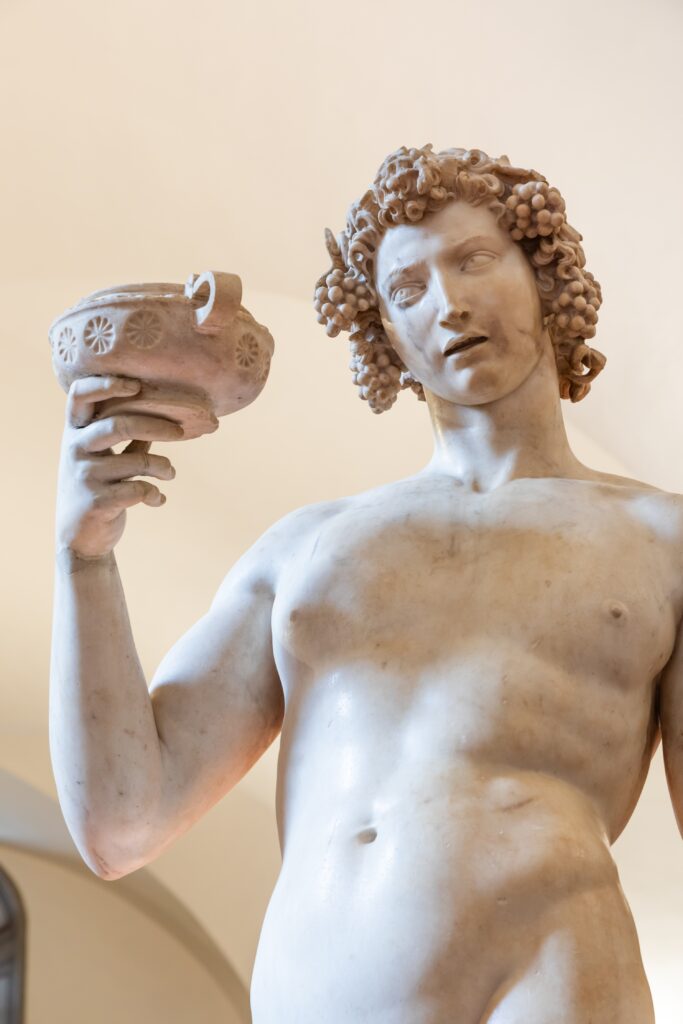
Bacchus depicts a nude god who appears a little tipsy and leering. He holds a goblet of wine, held up by a tree trunk and a fawn who steals his grapes. His hair is adorned with an identifying wreath of ivy leaves.
Legend has it that Michelangelo even broke off Bacchus’ penis to make the statue appear old. He did this with other sculptures too, burying them in dirt and smearing them with feces, as he was fascinated with ancient statues being dug up in Florence at the time.
Although Bacchus was not initially popular and was considered vulgar, it was groundbreaking in its portrayal of Bacchus drunk and in a flawlessly controlled disequilibrium. No sculptor had ever portrayed this before.
Here’s my guide to the Bargello Museum. Click here to pre-book a ticket.
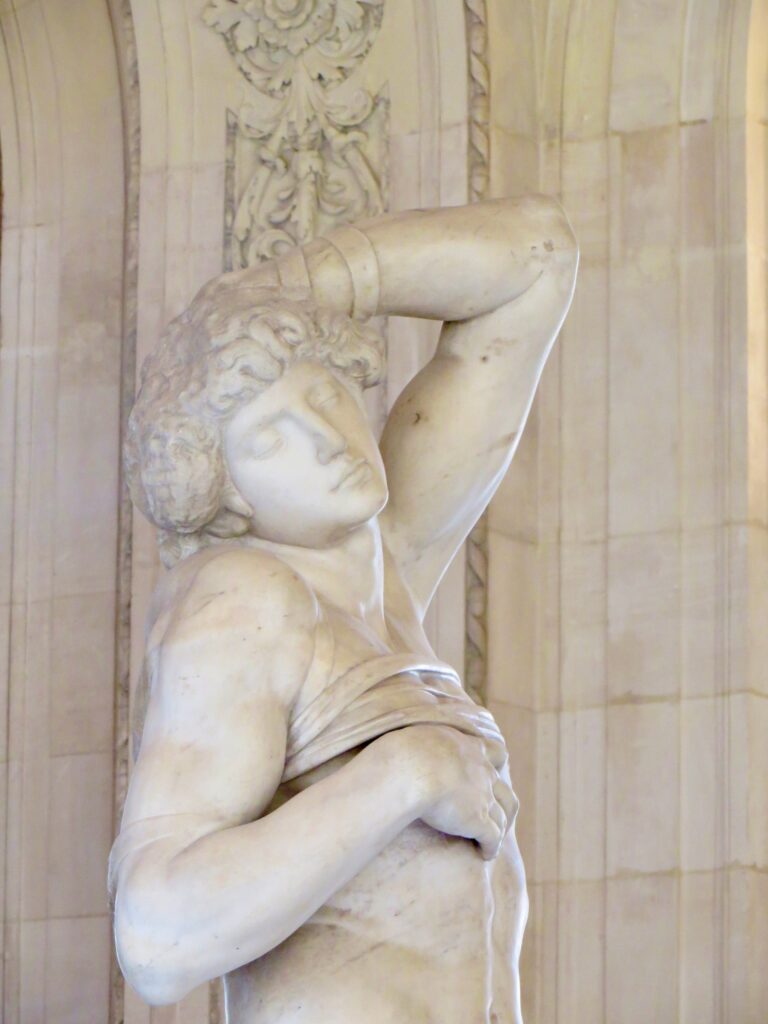
5. Dying Slave & Rebellious Slave, Louvre, Paris
The Louvre is home to two of Michelangelo’s most famous sculptures — the Dying Slave and the Rebellious Slave. They were also intended to decorate Julius II’s tomb.
The Dying Slave depicts a young male nude. He’s a figure in the throes of death, struggling to free himself from the stone.
His right hand lies on his chest, while his left is placed at the top of his head, which is tilted towards his right shoulder. The right leg is taut, the left relaxed with the heel raised, tilting the pelvis to his left.
The slave’s face has perfect features, framed by a cascade of wavy hair. His eyes are closed, and his whole countenance conveys the moment of death.
Michelangelo left the entire back of the sculpture in a rough state, with the surface still bearing the impressions of the hammers, rasps, and various types of chisel he used. This provides an interesting tactile experience.
The Rebellious Slave is a sculpture of a muscular male figure with his arms bound behind his back. His head is turned to the left as if he is straining against his restraints. His face is contorted in anguish or perhaps defiance, with his mouth open as if in a cry of pain or protest.
Like the Dying Slave, the figure appears to be struggling against the confines of the stone from which he was carved, as if he is emerging from the block of marble itself. This is a characteristic of Michelangelo’s work, which often portrays figures in the process of breaking free from their surroundings.
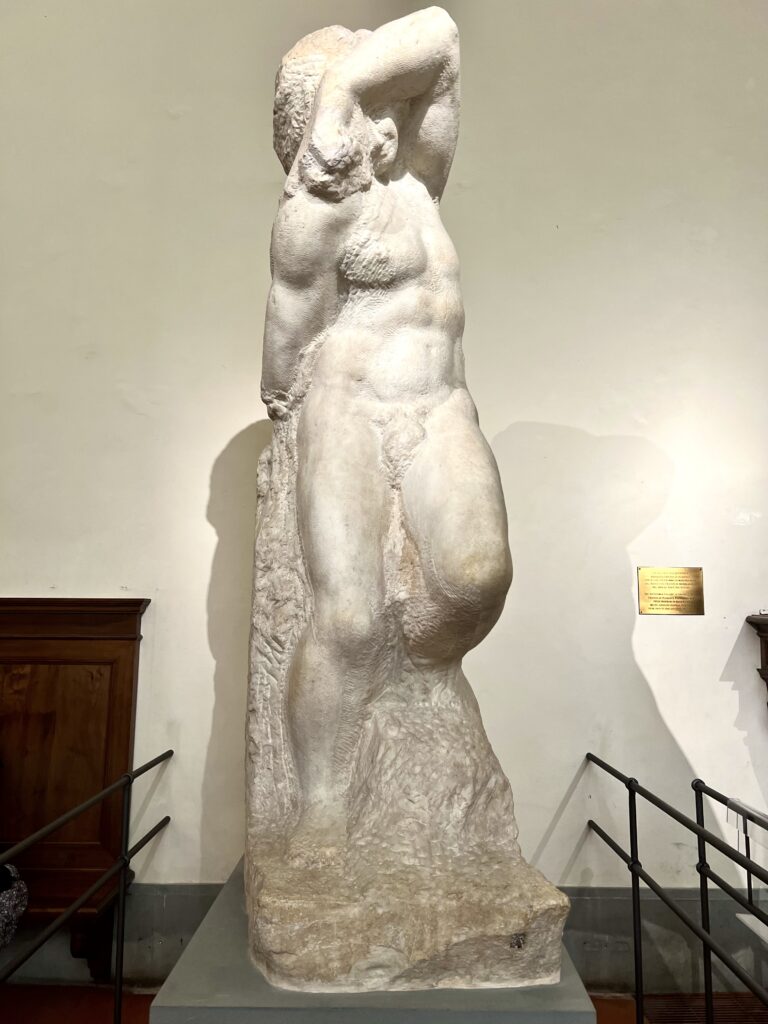
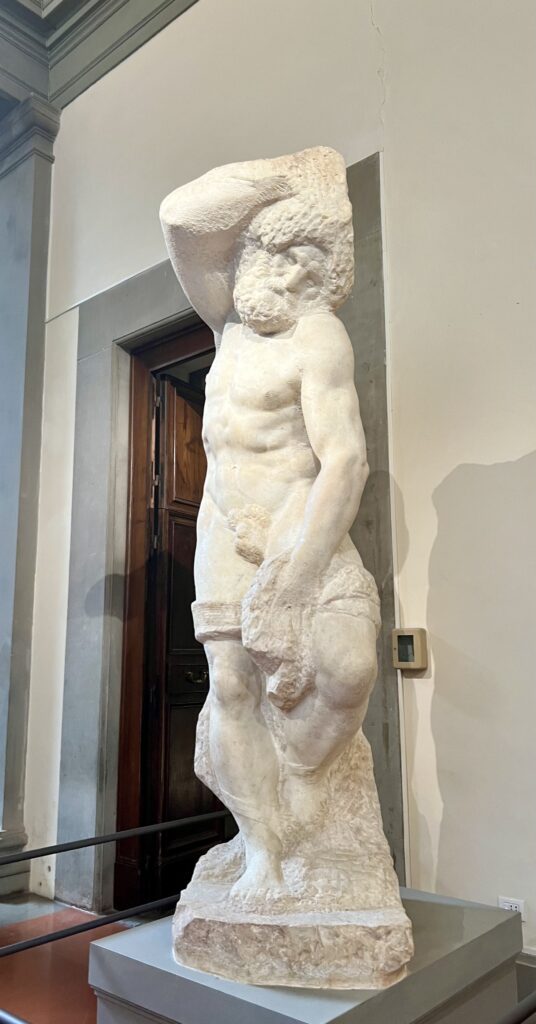
6. Slaves, Galleria Accademia, Florence
Thought Michelangelo’s Slaves in the Louvre are probably more famous, there are also four Slaves in Florence’s Galleria Acccademia.
In the Hall of the Prisoners, you can view Michelangelo’s incomplete Slaves. The sculptures have been titled The Awakening Slave, The Young Slave, The Bearded Slave, and The Atlas.
These figures were probably also intended for the Tomb of Pope Julius II.
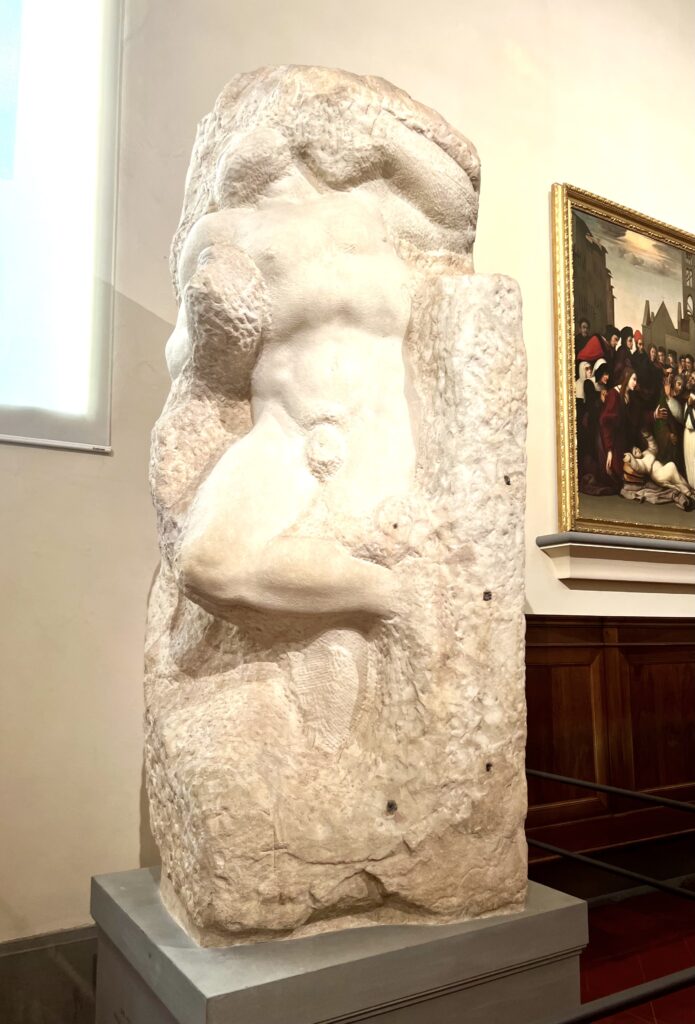
After Michelangelo’s death, the sculptures were acquired by Cosimo I de’ Medici, who placed them in the Buontalenti Grotto in the Boboli Gardens.
In 1909, they were transferred to the Accademia for preservation, while replicas were put in the grotto.
In addition to the Slaves, the Accademia also houses Michelangelo’s unfinished sculpture of St. Matthew. Originally, it was intended to be one of the twelve apostles on Florence Cathedral. But for unknown reasons, the project was abandoned.
7. Brutus, Bargello Museum, Florence
Michelangelo’s Bust of Brutus is his only known bust, commissioned by his friend Donato Giannotti for Cardinal Niccolo Ridolfi. The handsome bust is stylistically similar to ancient Roman busts, especially one of Caracalla.
The bust portrays the man who plotted to kill Julius Caesar, who was the first dictator after centuries of republican rule. Michelangelo intended the bust to represent freedom from tyranny, as Florence’s turbulent history paralleled that of Ancient Rome.
Florence became a Medici monarchy after being a democracy, and both Cardinal Ridolfi and Michelangelo were members of the republican faction that fought against the Medici.
Ironically, in 1590, the Medici family bought Michelangelo’s Bust of Brutus, which later traveled from the Uffizi to the Bargello. Today, the bust remains an important work of art that reflects the political and historical context of its creation.
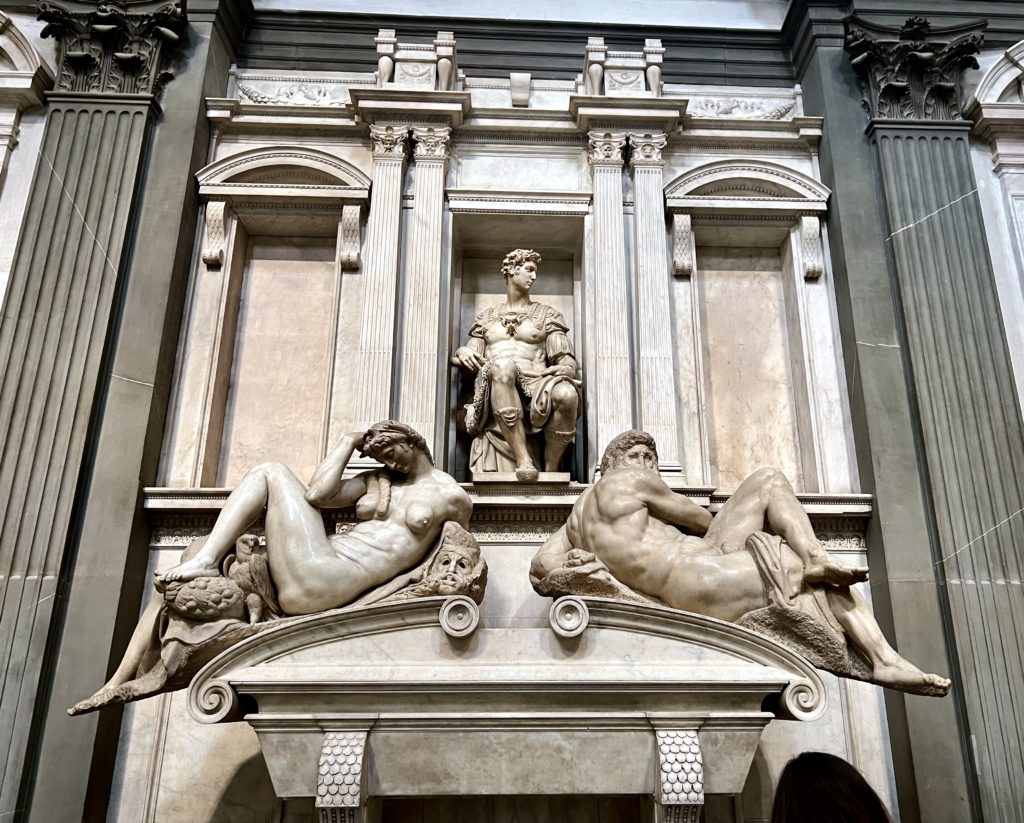
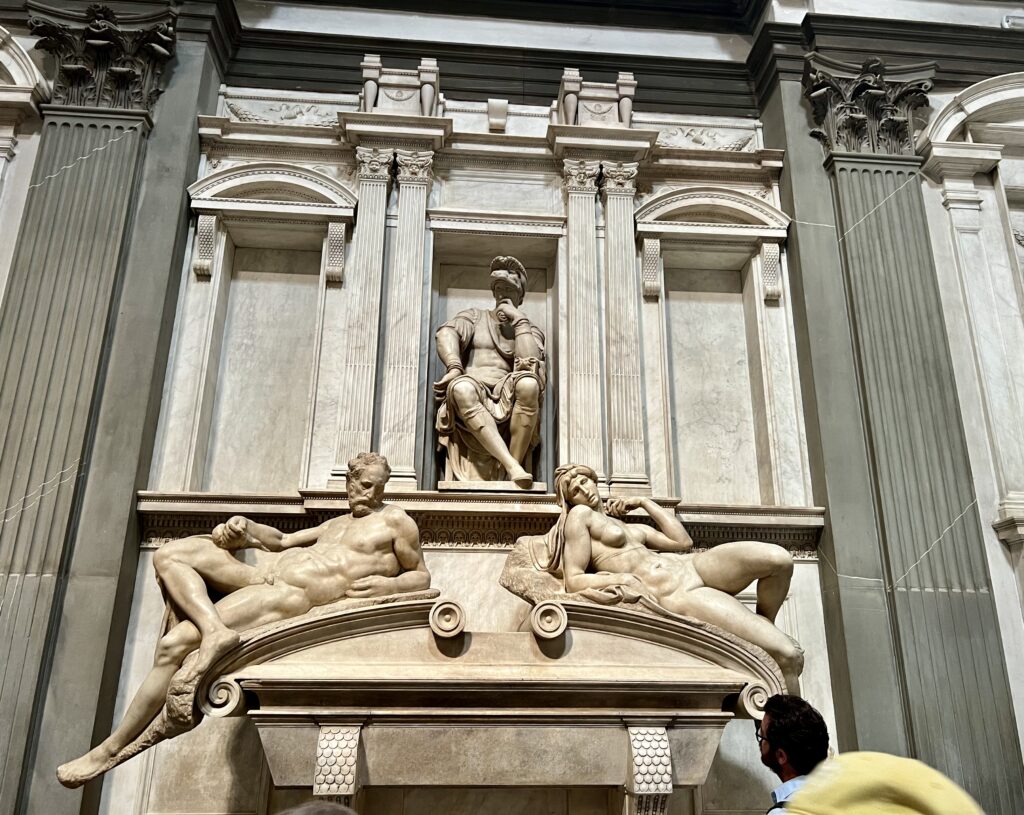
8. Allegories of Time, Medici Chapels, Florence
In the New Sacristy in the Medici Chapels, you’ll find Michelangelo’s famed allegorical works — the sculptures of Night, Day, Dawn, and Dusk.
They are on the tomb of Lorenzo de’ Medici (the grandson of Lorenzo the Magnificent) and the tomb of Giuliani de Medici (the third son of the Magnificent). It’s an irony that these grand tombs belong to relatively unimportant and rather wretched Medici offspring.
The allegories Michelangelo created conveyed a powerful message about the inescapable passage of time. They highlight how everything earthly will eventually succumb to death, while the soul endures.
Dusk, a male nude, suggests the onset of twilight and portrays a sense of weariness after the day’s toil.
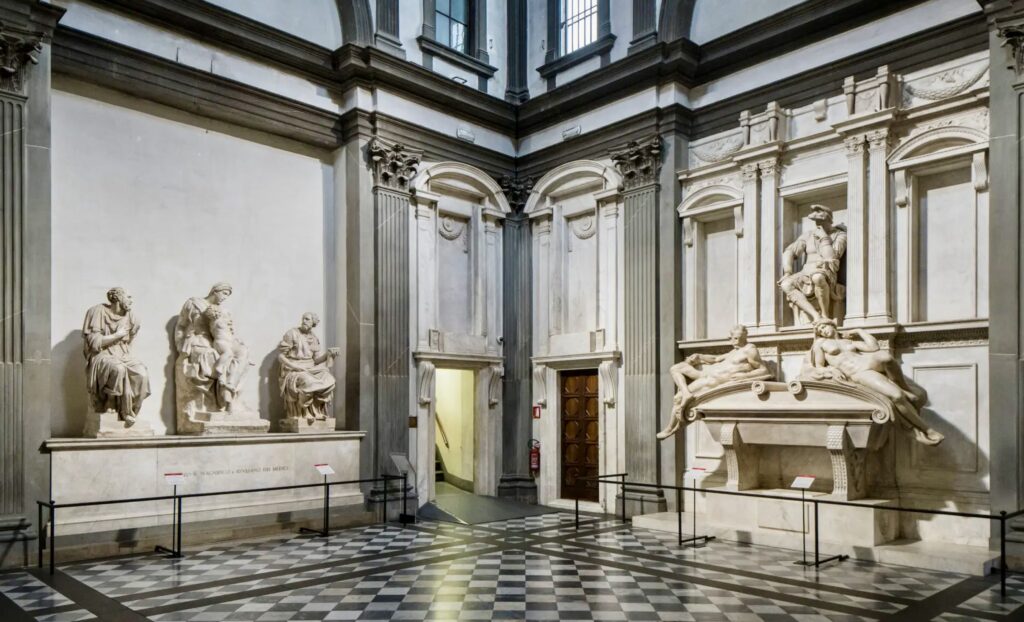
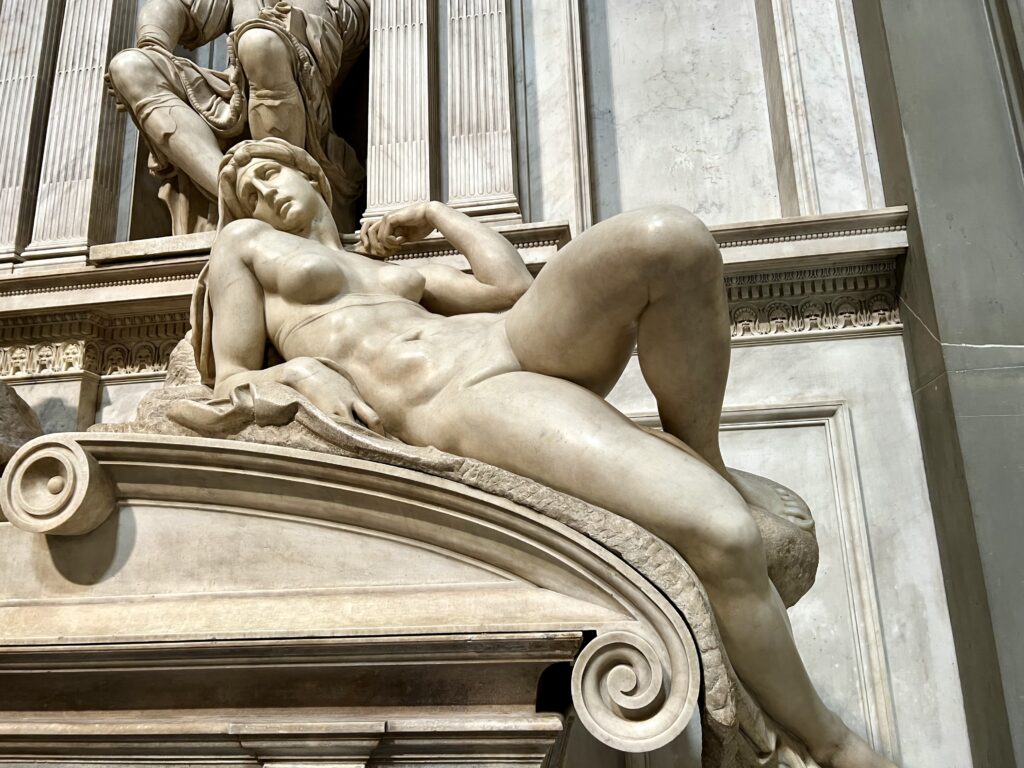
Dawn is a female figure that evokes the emergence of light as she appears to awaken from a dream. Her body is elongated and sinuous, with fluid lines and a sense of movement. The figure’s face is serene and peaceful, with a slight smile on her lips perhaps suggesting carnal pleasure.
Day represents masculinity, with a roughly finished face. The gaze towards the viewer conveys a sense of dominion.
Night is perhaps one of Michelangelo’s most stunning works. She is a youthful and athletic woman. Her head reclines on her right hand and her body is twisted in a nearly impossible position.
Michelangelo based her on a classical drawing of Leda, and the owl and bag of poppies at her feet further confirm her identity. Unlike the other allegories, Night is sleeping. Her highly polished and finished surface contrasts with the roughly hewn face of Day.
Michelangelo’s signature muscular and chiseled features are evident in Night’s appearance, with her breasts resembling tennis balls placed on a man’s body.
One breast appears disfigured, leading some to speculate that Michelangelo may have used a model who suffered from breast cancer. Regardless, Night remains an exceptional and powerful work of art that conveys Michelangelo’s immense skill and vision.
Here’s my complete guide to the Medici Chapels. To visit, you’ll need to pre-book a timed entry ticket. The chapels are a very popular attraction.
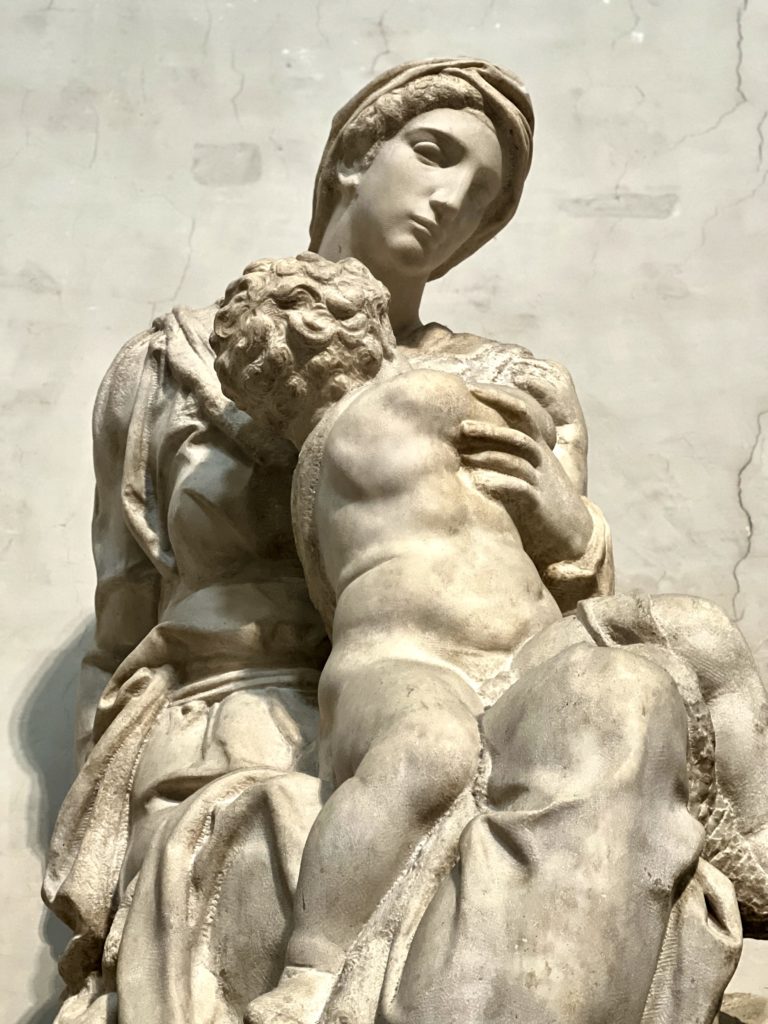
9. Medici Madonna, Medici Chapels, Florence
Michelangelo’s unfinished Medici Madonna is also in the New Sacristy of the Medici Chapels, over the tomb of Lorenzo the Magnificent.
Mary has a melancholy, thoughtful look on her face. She’s a powerful woman who grips her restless son in a gesture of possessive love. The baby is large and strong, perhaps presaging his future important role.
The sculpture is almost deviant in its depiction of the pair. Baby Jesus twists in a serpentine fashion backward to nurse. A lactating Jesus near a high altar?!
This piece may originally have been intended for Julius II’s tomb. Michelangelo was working on the chapel and the tomb simultaneously.
10. Florentine Pieta, Duomo Museum, Florence
The Florentine Pieta, also known as the Bandini Pieta or the Lamentation over the Dead Christ, is one of Michelangelo’s last (and unfinished) sculptures. He reputedly carved it for the altar of his own tomb and slaved away on it for from 1547 to 1555.
But it proved to be a formidable task, especially given his advancing age (around 80). When Michelangelo discovered defects in the marble, he destroyed parts of the sculpture in rage and never gave Christ a left leg.
Michelangelo’s servants sold off the pieces, and the new owner pieced them back together and reconfigured it. The figure supporting Christ’s arm isn’t by Michelangelo. But the figure holding Christ after his deposition, Nicodemus in the Bible, is likely a self-portrait of Michelangelo.
In November 2019, a restoration project on the sculpture was launched behind glass, in full view of the public. The intent was to remove grime, wax, and assess breakage. Some of the sculpture’s discoloration was just as Michelangelo suspected — due to flaws in the marble.
The Florentine Pieta is housed in the Duomo Museum in Florence. It’s one of the best museums in Florence, a veritable treasure box of Medieval and early Renaissance Florentine sculpture.
11. Rondanini Pieta, Castle Sforza, Milan
The Rondanini Pieta was Michelangelo’s last work of art. He worked on the sculpture up until 6 days before he died on February 18 1564 of complications of pneumonia.
The subject of the statue is a standing pieta. It was Michelangelo’s third version of the subject. Of the three pietas, this one is the most personal.
When you look at the sculpture, you see the figure of Christ in the foreground. Behind him is the figure of the Virgin Mary. You almost get the impression that Christ is giving a piggy back ride to his mother.
Michelangelo worked on the sculpture obsessively, almost as if he was trying to ward off death. In fact, he kept working until there wasn’t much of the sculpture left.
Instead of the muscular supermen Michelangelo typically sculpted, this sculpture is frail and suggests Michelangelo’s vulnerability at the time.
The Rondanini Pieta is located in the Sforza Castle Museum in Milan. For centuries, it was in the Rondanini Palace in Rome. In 1952, the city of Milan purchased it for an undisclosed price.
The castle has an entire hall dedicated to the pieta. The statue is in the center of a vast space all by itself. The pieta stands on an anti-seismatic podium that goes into the floor. (This is the type of base that David should be put on!)
Click here to pre-book a ticket to Castle Sforza.
12. Pitti Tondo, Bargello Museum, Florence
The Pitti Tondo is a graceful relief carving that was commissioned privately by Bartolomeo Pitti. It’s a round format, or tondo, is typical of domestic art.
The tondo depicts a common Renaissance theme: Mary with baby Jesus and St. John the Baptist, and is similar to Michelangelo’s painting, the Doni Tondo, in the Uffizi Gallery. As was Michelangelo’s tendency, the Pitti Tondo is deliberately unfinished, with raw contours.
In the relief, Mary sits on a square boulder, holding an open book and looking meditative. Next to the stern Madonna is a playful Jesus with pudgy flesh. Because of her size, Mary seems to burst from the carving, holding the book toward Jesus and pointing an index finger his way to underscore the moment.
Legend has it that Michelangelo carved the Pitti Tondo in response to Leonardo da Vinci’s return to Florence, particularly after seeing Leonardo’s heralded Madonna with Child and Anne.
The two had an intense rivalry, with Michelangelo detesting Leonardo and seeking to demonstrate his superiority.
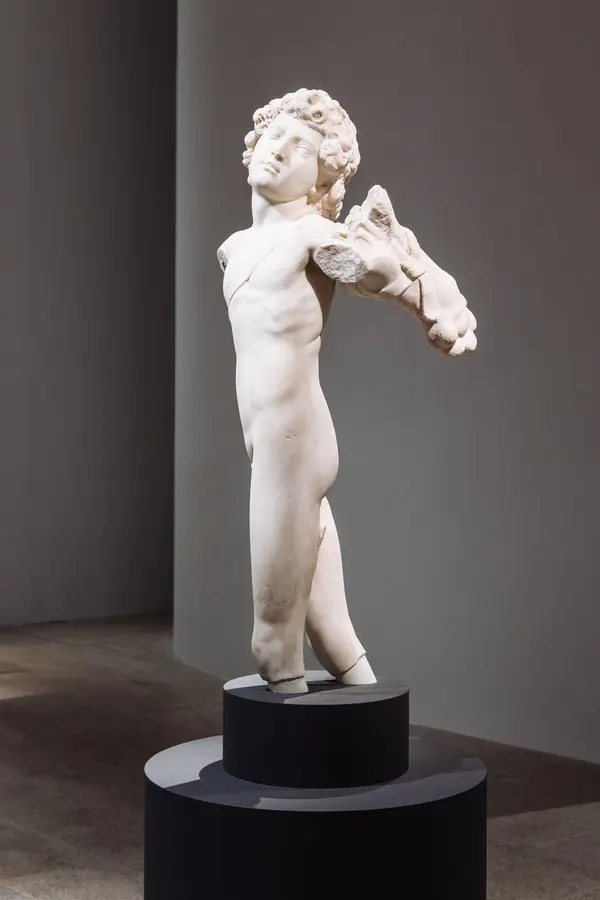
13. Cupid, Metropolitan Museum of Art, NYC
Michelangelo’s Cupid is a small marble sculpture currently housed in the Metropolitan Museum of Art in New York City. It’s the artist’s only marble sculpture in North America.
It’s an early work by Michelangelo, carved when he was around 21. It depicts a young boy, likely Cupid, who appears to be sleeping or resting. His head is tilted to the side and his arms relaxed at his sides.
The figure is nude, with highly detailed musculature and soft, flowing hair. The facial features are somewhat idealized, with a serene expression and delicate, slightly upturned nose. There are no wings, but you can see a quiver.
When the fragmentary sculpture first came to the US, its attribution to Michelangelo was practically forgotten. In 2017, a scholarly consensus emerged that it was an autograph Michelangelo.
Today, Michelangelo’s Cupid is the dramatic focal point in the Met’s gallery featuring 16th century Italian sculpture and decorative arts. Click here to book a ticket and tour of this fantastic museum.
I hope you’ve enjoyed my guide to Michelangelo’s most famous sculptures. You may enjoy these other travel guides that contain information on his great artworks:
- Michelangelo Trail in Florence
- Michelangelo Frescos in the Sistine Chapel
- Guide To Casa Buonarrotti
- Michelangelo’s Tomb in Florence’s Basilica of Santa Croce
- Guide To Michelangelo’s Laurentian Library In Florence
- Leonardo vs Michelangelo in Florence’s Palazzo Vecchio
- Michelangelo’s The Last Judgment Fresco
If you’d like to see Michelangelo’s most famous sculptures, pin it for later.

